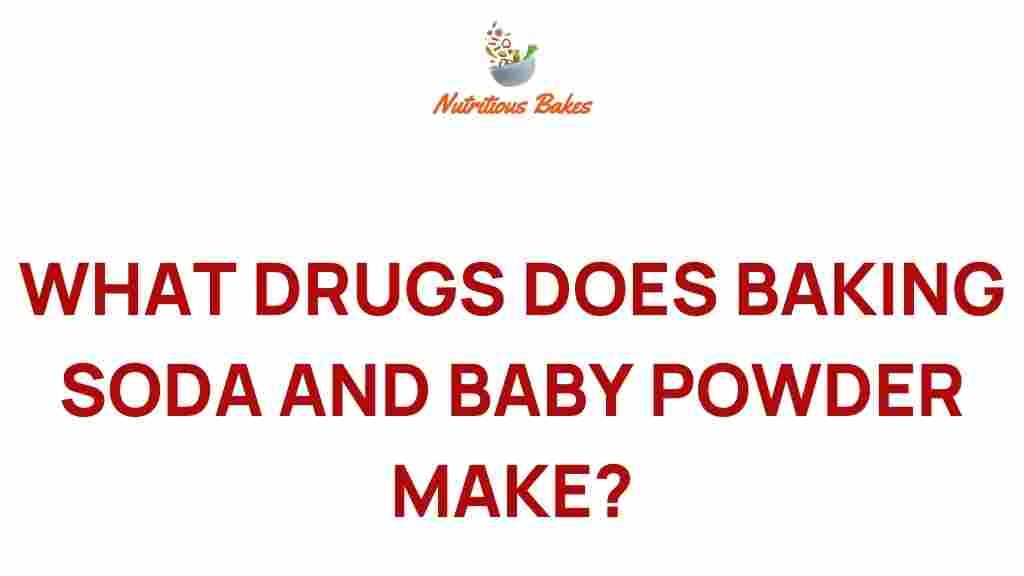The Alarming Chemistry: What Drugs Can Be Made with Baking Soda and Baby Powder?
In the realm of chemistry, many common household items can lead to surprising and often alarming outcomes. Two such items, baking soda and baby powder, are frequently found in homes around the world. While they serve safe and practical purposes in our everyday lives, it’s crucial to understand that these substances can also be manipulated in dangerous ways for illicit drug synthesis. This article delves into the chemistry behind baking soda and baby powder, exploring their potential use in drug manufacture, the chemical reactions involved, and the safety concerns that arise from their misuse.
Understanding the Basics: Baking Soda and Baby Powder
Baking soda, or sodium bicarbonate, is a versatile compound commonly used in baking, cleaning, and even personal care. Its chemical formula is NaHCO₃, and it acts as a leavening agent, neutralizing acids and creating carbon dioxide gas in the process.
Baby powder, primarily made from talc or cornstarch, is used for its moisture-absorbing properties. While talc is chemically inert, cornstarch is a carbohydrate that can be involved in various chemical reactions.
Drug Synthesis: The Alarming Potential
The synthesis of drugs often involves chemical reactions that can utilize common household items. Here, we explore how baking soda and baby powder can be linked to illicit drug manufacture.
1. Baking Soda in Drug Synthesis
Baking soda is frequently mentioned in the context of drug synthesis, particularly in the production of cocaine. The process often involves:
- Extraction of cocaine from coca leaves using solvents.
- Neutralization of hydrochloric acid in the cocaine solution by adding baking soda.
- Precipitation of freebase cocaine, which can be further processed for use.
This method illustrates how a common household item can play a critical role in illegal drug manufacture. The chemical reaction can produce harmful byproducts and poses significant safety risks.
2. Baby Powder and Its Role in Illicit Substances
Baby powder, particularly talc, has been misused as a cutting agent in the drug trade. Its fine texture makes it an appealing additive to increase bulk without significant cost. In drug synthesis, baby powder can:
- Be mixed with powdered drugs to enhance volume.
- Serve as a filler in tablets or capsules.
The use of baby powder in this manner raises serious safety concerns, as it can lead to the inhalation of harmful particles and other health risks associated with adulterated substances.
The Chemistry Behind the Reactions
Understanding the chemical reactions involved in drug synthesis can help illuminate the risks associated with these processes.
The Reaction of Baking Soda
When baking soda (NaHCO₃) is used in drug synthesis, it often reacts with acids. For instance, the neutralization reaction can be represented as follows:
NaHCO₃ + HCl → NaCl + H₂O + CO₂↑This reaction produces sodium chloride (table salt), water, and carbon dioxide gas. The release of gas can be dangerous in confined spaces, making safety precautions crucial.
The Role of Baby Powder in Chemical Reactions
Baby powder, particularly when made from cornstarch, can participate in reactions that produce unwanted byproducts. For example:
- When mixed with certain drugs, it can create a paste that is difficult to process.
- In high temperatures, talc can decompose, releasing harmful substances.
These chemical reactions highlight the necessity of understanding the implications of using household items in drug synthesis.
Safety Concerns and Legal Implications
The misuse of baking soda and baby powder in drug manufacture raises considerable safety concerns:
- Health Risks: Inhalation of fine powders can cause respiratory issues.
- Explosion Hazards: Chemical reactions can produce flammable gases.
- Legal Consequences: Engaging in drug synthesis is illegal and punishable by law.
Moreover, the use of household items in drug synthesis often leads to unpredictable outcomes, increasing the risk of serious accidents.
Step-by-Step Process: How These Substances Are Misused
While we do not endorse or encourage illegal activity, understanding the process can help raise awareness about the dangers involved.
Step 1: Extraction of Active Ingredients
The first step often involves extracting the active ingredients from plant materials, such as coca leaves for cocaine. This may involve the use of solvents that can be hazardous.
Step 2: Neutralization with Baking Soda
Next, the extracted solution is often neutralized using baking soda. This step is critical in the synthesis process and can lead to the formation of freebase substances.
Step 3: Mixing with Baby Powder
Finally, baby powder may be added as a cutting agent to increase bulk. This step is particularly dangerous as it can introduce impurities and health risks.
Troubleshooting Tips for Safety Concerns
For those who may encounter issues related to these substances, consider the following safety tips:
- Always Use Protective Gear: When dealing with chemicals, wear gloves, masks, and goggles.
- Work in Well-Ventilated Areas: Ensure that you are in a space with proper airflow to avoid inhalation of harmful substances.
- Know the Laws: Be aware of the legal implications of handling certain substances.
By following these tips, individuals can help mitigate some of the risks associated with chemical reactions involving baking soda and baby powder.
Conclusion: The Double-Edged Sword of Household Items
Baking soda and baby powder are exemplary of how common household items can have dual purposes—serving safe, everyday needs while also posing serious risks when misused in drug synthesis. Understanding the chemistry behind these substances, the potential for illicit drug manufacture, and the associated safety concerns is crucial for anyone interested in chemistry.
As we continue to explore the boundaries of chemistry, it is essential to remain aware of the potential dangers that can arise from manipulating everyday items. Education and awareness are key to preventing misuse and protecting public health.
For more information on household chemistry and safety, check out this comprehensive guide. If you’re interested in the science of drug synthesis and its implications, consider visiting this resource for further reading.
This article is in the category Tips and created by NutritiousBakes Team
